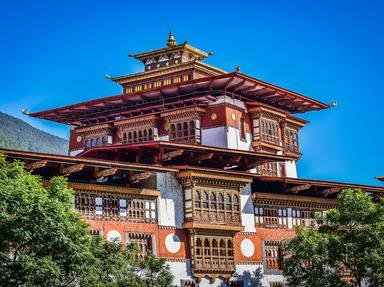Quiz Answer Key and Fun Facts
1. The opening phrase of the Bhutanese national anthem translates into English as "In the kingdom of Druk". Can you guess what kind of mythological creature a Druk (an image of which appears on the national flag) is?
2. Which of these regions of China (which, at the start of the 21st century, considered itself to be an independent nation occupied by invading forces) is the northern neighbour of Bhutan?
3. What is the chief mountain range to be found in Bhutan?
4. The second line of Bhutan's national anthem reads "Refuge of the glorious monastic and civil traditions", in reference to the fact that the current society has grown from the roots established by the monks who settled there in the 17th century. The official language of Bhutan is Dzongkha. How does this translate into English?
5. The rulers of Bhutan are called Druk Gyalpo. Given that the country's full formal name in English is the Kingdom of Bhutan, it can be deduced that Gyalpo is best translated by which of the following?
6. In the 12th century, the Drukpa Kargyu school of Bhutan's dominant religion was established. Within what religion did this 'new school' of ideas develop?
7. Which of these statements about the colonial status of Bhutan is most accurate?
8. Which of these statements about the climate of Bhutan is FALSE?
9. Which of these does NOT form a significant part of Bhutan's economy?
10. Bhutan is considered to be a world leader in terms of conservation practices. What percentage of the country was set (in the 1990s) as the minimum to be maintained as forest?
Source: Author
looney_tunes
This quiz was reviewed by FunTrivia editor
Tizzabelle before going online.
Any errors found in FunTrivia content are routinely corrected through our feedback system.

